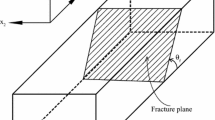Abstract
A model is presented of the origination and suppression of the fracture of a contact surface during shear of its layers. The process is examined as a function of the configuration of projections on the rigid body, the thickness of the layers undergoing deformation, and the distribution of the contact stresses. Two mechanisms of fracture suppression on the contact surface are found: an unstable mechanism dependent on the thickness of the layer undergoing shear and the properties, roughness, and condition of the surface of the material being deformed; a stable mechanism independent of these factors. Both mechanisms are found to be of practical value in the solution of problems which involve increasing the strength of contact layers and resistance welds in various structures and optimizing regimes of plastic deformation and resistance welding. Criteria of contact strength are also presented for ductile and low-ductility materials.
Similar content being viewed by others
Literature cited
K. Johnson, Mechanics of Contact Interaction [Russian translation], Mir, Moscow (1989).
Yu V. Kolesnikov and E. M. Morozov, Mechanics of Contact Fracture [in Russian], Nauka, Moscow (1989).
G. S. Pisarenko, Current Problems of Strength in Engineering: Mechanics and Scientific-Technical Progress [in Russian], Vol. 3 of The Mechanics of Deformable Bodies, Nauka, Moscow (1988), pp. 64–74.
V. I. Likhtman, E. D. Shukin, and P. A. Rebinder, Physicochemical Mechanics of Metals. Adsorption Phenomena in the Deformation and Fracture of Metals [in Russian], Izd. Akad. Nauk SSSR, Moscow (1962).
E. A. Kuznetsov and G. A. Gorokhovskii, “Frictional interaction of rough bodies from the viewpoint of rigid-body mechanics,” Trenie Tznos, 1, No. 4, 538–649 (1980).
Increasing the Load-Carrying Capacity of Machine Parts by Work-Hardening [in Russian], Mashinostroenie, Moscow (1988).
Yu. G. Proskuryakov, V. N. Romanov, and A. N. Isaev, Internal Broaching [in Russian], Mashinostroenie, Moscow (1984).
A. V. Vesnitskii, “Suppression of cracks in a contact surface during shear of its layers,” Studies of the Plastic Deformation and Shaping of Metals [in Russian], Tula Polytechnic Institute, Tula (1986), pp. 43–50.
G. E. Arkulis and V. G. Dorogobid, Theory of Plasticity: A Text for Vocational Institutes [in Russian], Metailurgiya, Moscow (1987)
V. L. Kolmogorov, Mechanics of Friction [in Russian], Nauka i Tekhnika, Minsk (1974).
A. S. Akhmatov, Molecular Physics of Limiting Friction [in Russian], Fizmatgiz, Moscow (1968).
G. S. Pisarenko, A. P. Yakovlev, and V. V. Matveev, Handbook of the Strength of Materials [in Russian], Naukova Dumka, Kiev (1988).
Author information
Authors and Affiliations
Additional information
Translated from Problemy Prochnosti, No. 6, pp. 26–32, June, 1992.
Rights and permissions
About this article
Cite this article
Vesnitskii, A.V. Criteria of the contact strength, ductility, and fracture of materials in shear with buckling. Strength Mater 24, 402–408 (1992). https://doi.org/10.1007/BF00776938
Received:
Issue Date:
DOI: https://doi.org/10.1007/BF00776938




